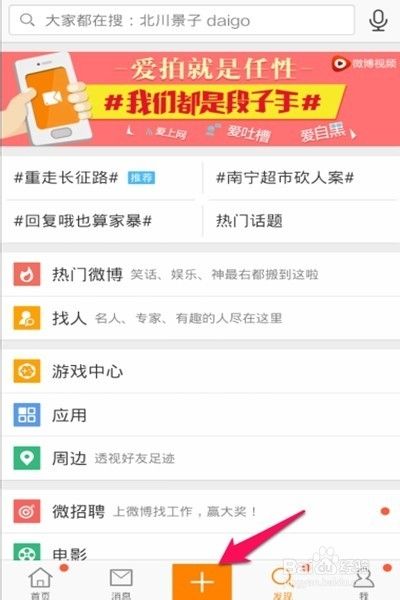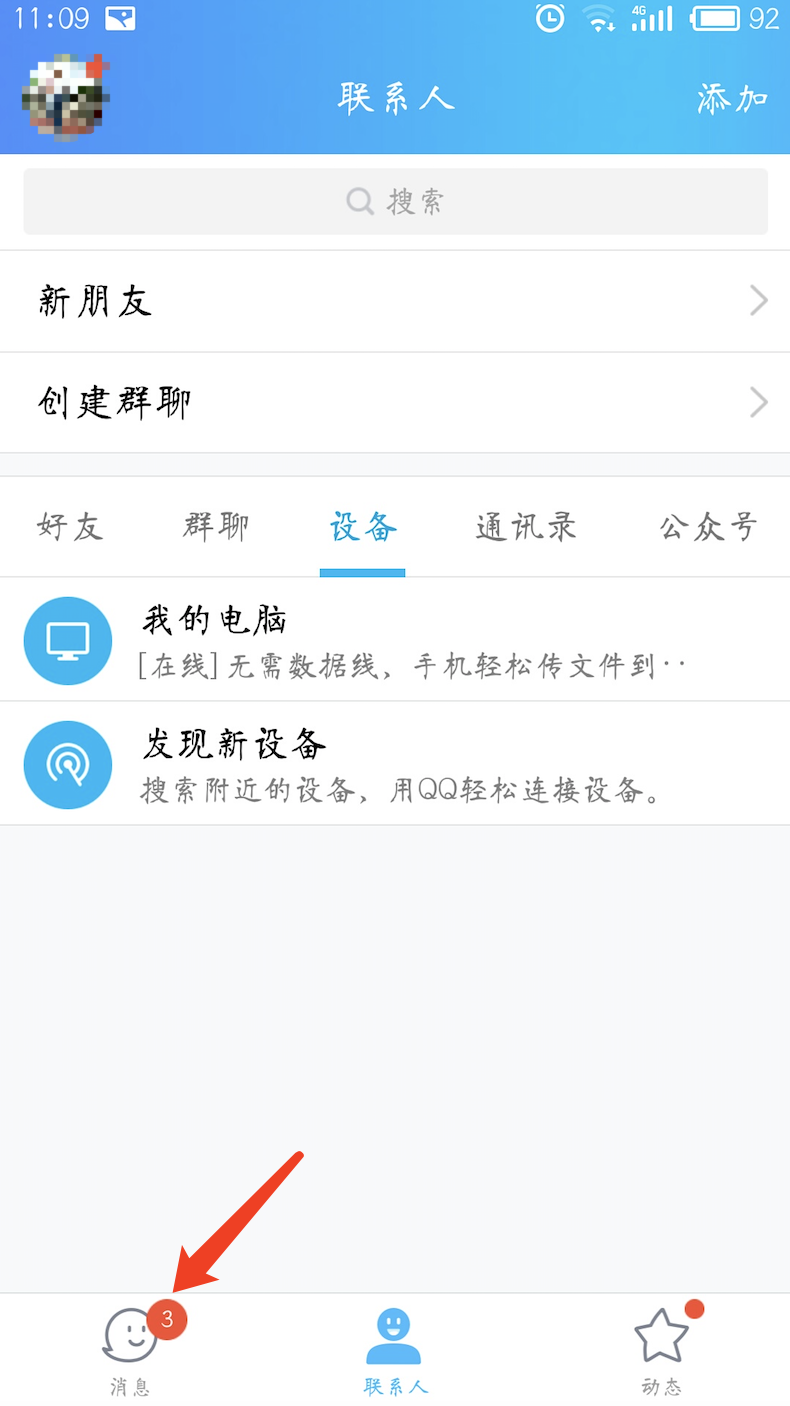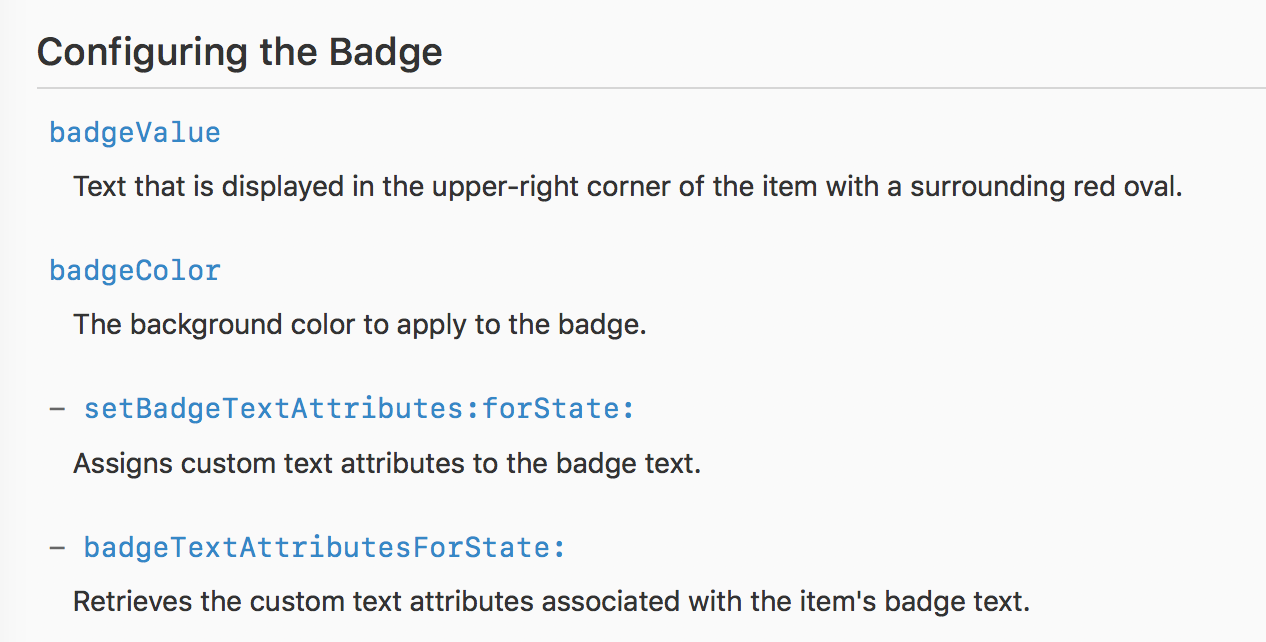详解iOS自定义UITabBar与布局
在小编整理过的文章iOS项目基本框架搭建中,我们详细说明了如何对TabBarItem的图片属性以及文字属性进行一些自定义配置。但是,很多时候,我们需要修改TabBarItem的图片和文字属性之外,还需要自定义TabBarItem的位置,这样系统自带的TabBar的样式并不能满足我们的项目需求,所以我们需要对系统的UITabBar进行自定义,以达到我们的项目需求。例如新浪微博App的底部tab的item就无法用自带的TabBarItem进行实现,最中间那个【+】发布微博并不是用来切换tab的,而是在当前的页面上覆盖一个编辑发布页面,发布完成或者取消发布之后又回到之前的页面,并没有进行切换,这时候我们就需要对TabBar进行自定义,在最中间空出一个TabBar的空间进行布置这个【+】发布按钮。


我们的项目是仿写“百思不得姐”App的功能模块进行学习和提高,其TabBar的样式与微博的样式基本相似(如上图右边的图),最中间的Tab按钮也是发帖功能,也是在直接当前的页面上覆盖一个编辑发布页面,发布完成或者取消发布之后又回到之前的页面,并没有进行切换。
解决方案
对于类似新浪微博和我们项目中这种情况有两种解决思路:
定义5个TabBarItem,然后在TabBar上添加一个与TabBarItem等大小的发布按钮在最中间,并添加点击事件,这样因为大小相等,所以新按钮完全覆盖了最中间的TabBarItem,最中间的TabBarItem的响应事件也会被屏蔽,因为按钮会先响应自定义TabBar,重写其 layoutSubviews 方法,将所有4个TabBarItem的布局和大小进行修改,将中间空出来,然后添加一个自定义的【发布】按钮,实现其点击事件即可 1 覆盖控件实现方案
这种方案的思路在上面已经说到了,就是先占一个位置,然后用一个按钮覆盖到其上面。主要缺点就是需要先申请一个位置和控制器来占位比较浪费,而且这种也只适用于各控件的大小是均匀的情况,当我们需求中每个TabBarItem的规格和尺寸不一样时,我们就无法使用这种方案实现。
有几点值得说明一下:
设置所有UITabBarItem的文字属性在上一篇文章iOS项目——基本框架搭建中已经提到了,这里就不详细介绍了【发布】按钮的初始化应该使用单例模式进行创建,因为我们项目中只有一个【发布】按钮,所以使用单例模式更合理,本文采用懒加载的方式进行单例模式的创建在 viewWillAppear: 中添加【发布】按钮 [self.tabBar addSubview:self.publishButton]; 。至于为什么要在 viewWillAppear: 中添加【发布】按钮而不是在 viewDidLoad 中添加?根本原因就是TabBarItem加载到TabBar上是在 viewDidLoad 之后执行的,后面在第2部分中有验证这一点, 在上一文章我们就说过,tabbarcontroller是在一创建控制器的时候就进行加载viewdidLoad。所以,如果添加【发布】按钮在viewDidLoad中会造成【发布】按钮在TabBar中是第一个添加的,这样会导致【发布】按钮会被TabBarItem覆盖了,这样我们就达到我们的目的。
#import "XMGTabBarController.h"
@interface XMGTabBarController ()
/** 中间的发布按钮 */
@property (nonatomic, strong) UIButton *publishButton;
@end
@implementation XMGTabBarController
#pragma mark - 初始化
- (void)viewDidLoad {
[super viewDidLoad];
/**** 设置所有UITabBarItem的文字属性 ****/
UITabBarItem *item = [UITabBarItem appearance];
// 普通状态下的文字属性
NSMutableDictionary *normalAttrs = [NSMutableDictionary dictionary];
normalAttrs[NSFontAttributeName] = [UIFont systemFontOfSize:14];
normalAttrs[NSForegroundColorAttributeName] = [UIColor grayColor];
[item setTitleTextAttributes:normalAttrs forState:UIControlStateNormal];
// 选中状态下的文字属性
NSMutableDictionary *selectedAttrs = [NSMutableDictionary dictionary];
selectedAttrs[NSForegroundColorAttributeName] = [UIColor darkGrayColor];
[item setTitleTextAttributes:normalAttrs forState:UIControlStateSelected];
/**** 添加子控制器 ****/
[self setupOneChildViewController:[[UITableViewController alloc] init] title:@"精华" image:@"tabBar_essence_icon" selectedImage:@"tabBar_essence_click_icon"];
[self setupOneChildViewController:[[UITableViewController alloc] init] title:@"新帖" image:@"tabBar_new_icon" selectedImage:@"tabBar_new_click_icon"];
// 中间用来占位的子控制器
[self setupOneChildViewController:[[UIViewController alloc] init] title:nil image:nil selectedImage:nil];
[self setupOneChildViewController:[[UIViewController alloc] init] title:@"关注" image:@"tabBar_friendTrends_icon" selectedImage:@"tabBar_friendTrends_click_icon"];
[self setupOneChildViewController:[[UITableViewController alloc] init] title:@"我" image:@"tabBar_me_icon" selectedImage:@"tabBar_me_click_icon"];
}
/**
* 为什么要在viewWillAppear:方法中添加发布按钮?
* 当viewWillAppear:方法被调用的时候, tabBar内部已经添加了5个UITabBarButton
* 就可以实现一个效果 : [发布按钮]盖在其他UITabBarButton上面
*/
- (void)viewWillAppear:(BOOL)animated
{
[super viewWillAppear:animated];
/**** 增加一个发布按钮 ****/
[self.tabBar addSubview:self.publishButton];
}
#pragma mark - 懒加载
/** 发布按钮 */
- (UIButton *)publishButton
{
if (!_publishButton) {
_publishButton = [UIButton buttonWithType:UIButtonTypeCustom];
_publishButton.backgroundColor = XMGRandomColor;
[_publishButton setImage:[UIImage imageNamed:@"tabBar_publish_icon"] forState:UIControlStateNormal];
[_publishButton setImage:[UIImage imageNamed:@"tabBar_publish_click_icon"] forState:UIControlStateHighlighted];
_publishButton.frame = CGRectMake(0, 0, self.tabBar.frame.size.width / 5, self.tabBar.frame.size.height);
_publishButton.center = CGPointMake(self.tabBar.frame.size.width * 0.5, self.tabBar.frame.size.height * 0.5);
[_publishButton addTarget:self action:@selector(publishClick) forControlEvents:UIControlEventTouchUpInside];
}
return _publishButton;
}
#pragma mark - 监听
/**
* 发布按钮点击
*/
- (void)publishClick
{
XMGLogFunc
XMGTestViewController *test = [[XMGTestViewController alloc] init];
[self presentViewController:test animated:YES completion:nil];
}
@end
2 自定义TabBar
自定义TabBar可以完全按照我们的需求来布局和配置TabBar中各子控件的属性和布局。
@interface XMGTabBarController ()
@end
@implementation XMGTabBarController
#pragma mark - 初始化
- (void)viewDidLoad {
[super viewDidLoad];
/**** 设置所有UITabBarItem的文字属性 ****/
//省略
/**** 添加子控制器 ****/
[self setupOneChildViewController:[[UITableViewController alloc] init] title:@"精华" image:@"tabBar_essence_icon" selectedImage:@"tabBar_essence_click_icon"];
[self setupOneChildViewController:[[UITableViewController alloc] init] title:@"新帖" image:@"tabBar_new_icon" selectedImage:@"tabBar_new_click_icon"];
[self setupOneChildViewController:[[UIViewController alloc] init] title:@"关注" image:@"tabBar_friendTrends_icon" selectedImage:@"tabBar_friendTrends_click_icon"];
[self setupOneChildViewController:[[UITableViewController alloc] init] title:@"我" image:@"tabBar_me_icon" selectedImage:@"tabBar_me_click_icon"];
/**** 更换TabBar ****/
[self setValue:[[XMGTabBar alloc] init] forKeyPath:@"tabBar"];
}
@end
下面的代码是我们自定义TabBar的.m文件的主要内容,主要是重写其 layoutSubviews 方法,在该方法中我们是将四个按钮的大小和布局进行了调整,然后在最中间添加一个【发布】按钮。同样的,也有几点需要注意的:
【发布】按钮的初始化还是和上面一样,应该采用单例模式进行初始化,具体就不展开;重写 layoutSubviews 方法时,应该先调用其父类的此方法 [super layoutSubviews]; ,这样可以先对TabBarItem进行布局,然后在此布局的基础上进行布局调整。调用父类布局方法的语句不能放在后面,更不能省略,因为此方法除了对TabBarItem进行布局之外还有很多其他的配置;通过 self.subviews 来获取当前的子控件,我们可以先进行打印了解当前子控件的类型和数量,然后进行适当的筛选出我们需要修改的控件进行布局,我们一般这里采用KVC的方法进行获取和修改,例如上面我们修改当前的TabBar [self setValue:[[XMGTabBar alloc] init] forKeyPath:@"tabBar"]; ,关于如何获取属性和成员变量可以参见:runtime获取属性和成员变量
#import "XMGTabBar.h"
@interface XMGTabBar()
/** 中间的发布按钮 */
@property (nonatomic, weak) UIButton *publishButton;
@end
@implementation XMGTabBar
#pragma mark - 懒加载
/** 发布按钮 */
- (UIButton *)publishButton
{
if (!_publishButton) {
UIButton *publishButton = [UIButton buttonWithType:UIButtonTypeCustom];
publishButton.backgroundColor = XMGRandomColor;
[publishButton setImage:[UIImage imageNamed:@"tabBar_publish_icon"] forState:UIControlStateNormal];
[publishButton setImage:[UIImage imageNamed:@"tabBar_publish_click_icon"] forState:UIControlStateHighlighted];
[publishButton addTarget:self action:@selector(publishClick) forControlEvents:UIControlEventTouchUpInside];
[self addSubview:publishButton];
_publishButton = publishButton;
}
return _publishButton;
}
#pragma mark - 初始化
/**
* 布局子控件
*/
- (void)layoutSubviews
{
[super layoutSubviews];
/**** 设置所有UITabBarButton的frame ****/
// 按钮的尺寸
CGFloat buttonW = self.frame.size.width / 5;
CGFloat buttonH = self.frame.size.height;
CGFloat buttonY = 0;
// 按钮索引
int buttonIndex = 0;
for (UIView *subview in self.subviews) {
// 过滤掉非UITabBarButton
// if (![@"UITabBarButton" isEqualToString:NSStringFromClass(subview.class)]) continue;
if (subview.class != NSClassFromString(@"UITabBarButton")) continue;
// 设置frame
CGFloat buttonX = buttonIndex * buttonW;
if (buttonIndex >= 2) { // 右边的2个UITabBarButton
buttonX += buttonW;
}
subview.frame = CGRectMake(buttonX, buttonY, buttonW, buttonH);
// 增加索引
buttonIndex++;
}
/**** 设置中间的发布按钮的frame ****/
self.publishButton.frame = CGRectMake(0, 0, buttonW, buttonH);
self.publishButton.center = CGPointMake(self.frame.size.width * 0.5, self.frame.size.height * 0.5);
}
#pragma mark - 监听
- (void)publishClick
{
XMGLogFunc
}
@end
为了验证现在1中提到TabBar加载TabBarItem是在 viewDidLoad 之后执行,我们在自定义TabBar时进行断点调试,发现确实是先运行XMGTabBarController的 viewDidLoad方法,然后才运行自定义TabBar的 layoutSubviews 方法。
3 添加红点提示
现在很多App的TabBarItem在有新消息时在右上角会有一个红点提示,有的甚至还会有具体数目的提醒,类似我们常用的QQ、微信、微博、头条等都会有类似的功能,这个提示在iOS中的学名叫做badge(其实是一般都这么命名而已)。在iOS的TabBarItem是自带该属性和控件的,我们可以根据自己的需求进行配置,下图是iOS11中的配置文档,可以对提示数量、颜色进行自定义设置,还可以对提示文字的属性进行不同状态下的配置。

据说在iOS10之前对badge的提示颜色是不能进行配置的,这时候如果需要,我们就只能进行自定义TabBarItem,然后对自定义的badge进行配置。本文就不对这一点进行详细说明了,有需要的小伙伴可以自行求助度娘。

